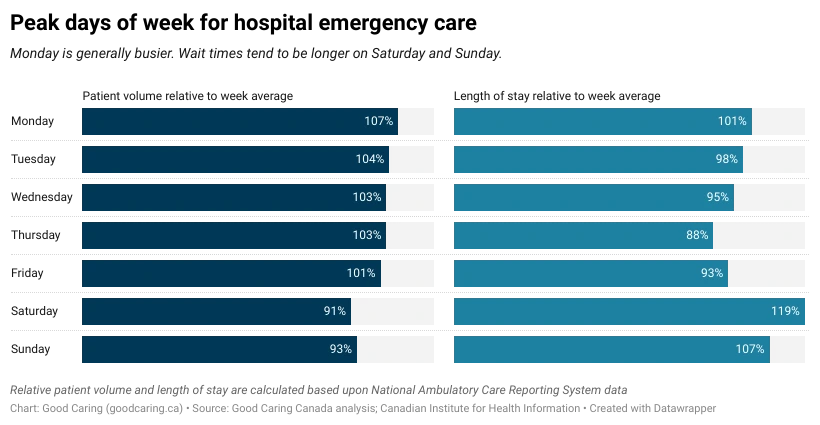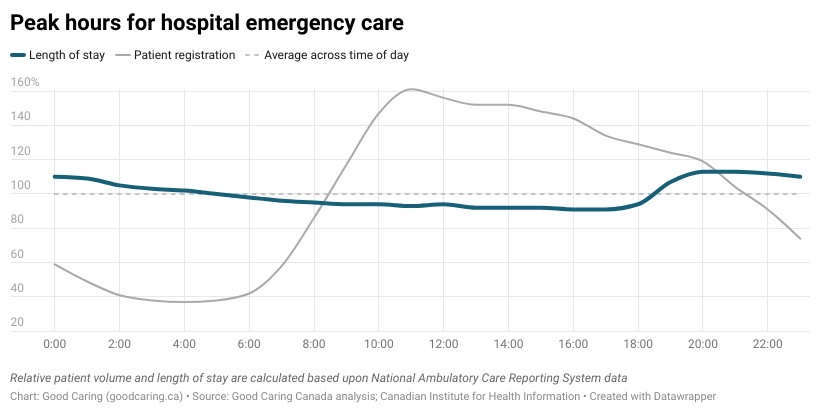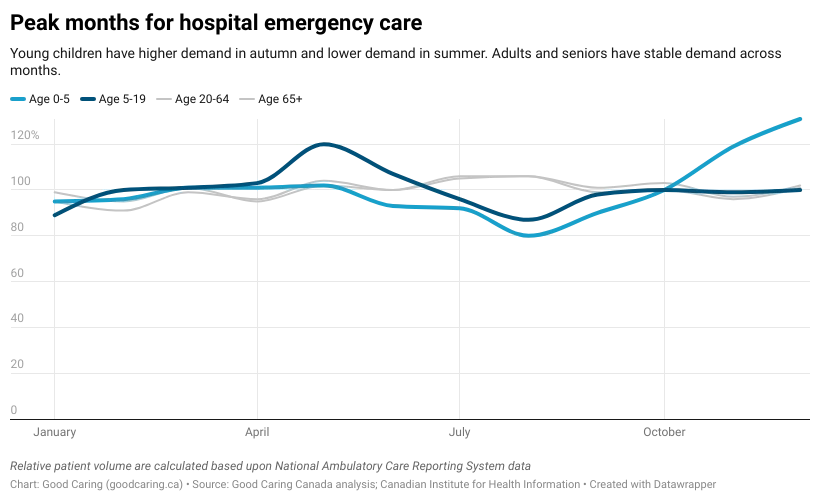Emergency department wait times can be long for Calgary residents. Long wait times can delay critical care, reduce patient satisfaction, and increase the risk of complications.
💡 Consider advice for protecting yourself from germs, preparing for long wait times, avoiding peak times, and finding alternative care.
⬇️ Scroll down to compare hospitals by expected wait time. Confirm the current expected wait time when you arrive at the hospital.
Wait time is defined as the time between (a) the earlier of triage time or registration time; and (b) the time of physician initial assessment in the emergency department.
Planning for peak times and seasonality
Planning your visit to the emergency department can significantly impact wait times, particularly if the medical issue is not urgent.

Mondays tend to be the busiest day of the week in hospital emergency departments. The accumulation of non-emergency cases over the weekend often result in a surge of patient volume on the first work day of the week.
If your condition allows for flexibility in seeking care, consider the day of the week for your visit. Avoid Mondays and weekends.

The time of day is unlikely to significantly reduce wait times, as hospitals align staff availability with patient volumes.
During standard business hours, from morning to early evening, full staffing is in place. However, higher patient volumes during these times can create bottlenecks. Even with more medical personnel, increased demand can still lead to longer waits as emergency departments handle the influx of patients.
Late-night and early-morning hours may seem ideal due to fewer patients. However, reduced staffing during these hours often negates the benefit of a smaller patient load. Patients may still face long waits due to limited healthcare providers.

Demand seasonality can affect wait times in emergency departments across Canada, particularly among younger patients. Young children, aged 0 to 5, see a rise in emergency visits during autumn, with a notable decline in the summer months. Children, aged 5 to 19, experience a peak in spring and a similar decrease in the summer.
Adults, aged 20 to 64, generally show consistent demand for emergency care throughout the year. Seniors over 65 also follow a steady pattern, with minimal seasonal fluctuations.
Protecting yourself and family
When visiting the emergency department, it is important to be aware that crowded waiting areas can increase the risk of exposure to illness. Hospitals are often filled with patients with various contagious conditions. While waiting for emergency care, many patients may unknowingly contract illnesses.
Protecting yourself requires proactive measures:
- 😷 Wear a mask. One of the simplest and most effective ways to protect yourself from airborne illnesses is to wear a mask. Masks are particularly important during flu season.
- 🧴 Practice hand hygiene. Contact with shared surfaces, such as chairs, doorknobs, and check-in kiosks, can expose you to pathogens. Regularly wash your hands with soap and water. Use a hand sanitizer.
- 📱 Protect belongings. Germs can transfer to your belongings. Keep personal items, such as phones and bags, away from shared surfaces. If you must place personal items on a public surface, be sure to clean them.
- 💪🏼 Boost your immune system. Appropriate vitamin and mineral supplements can provide an extra layer of protection. Vitamin C, Vitamin D, and zinc can boost immune function to help your body fight infections.
Preparing for extended wait times
Long wait times are often unavoidable, especially during busy periods or when non-urgent conditions are being treated. Preparing for an extended stay can make the experience more comfortable and help reduce stress.
- 🧣 Bring comfort aids. Prolonged sitting can bring uncomfortable or painful, especially for the older adults. Bring a neck pillow, lumbar cushion and a blanket.
- 🎧 Wear noise-cancelling headphones. Hospitals can be noisy environments, which can increase stress. Use noise-cancelling headphones to block out the surrounding commotion.
- 🍪 Pack healthy snacks. Hospitals may have limited food options. Bring snacks to sustain energy levels. Consider nuts, fruit, whole-grain crackers, or granola bars. Check with the medical staff if fasting is required before treatment.
- 🧦 Dress comfortably. Hospitals can have variable temperatures. Dress in layers. Wear loose, comfortable clothing.
- 🎮 Bring personal entertainment. Entertainment can reduce stress and make the wait feel shorter. Consider a book, tablet for web browsing, videos, music, and podcasts.
Hospitals with shortest emergency wait times
Below are five top hospitals in Calgary which have the shortest emergency department wait times:
- 🥇 Vulcan Community Health Centre has the shortest maximum emergency wait time at 2.2 hours in Calgary
- 🥈 Mineral Springs Hospital, with a maximum wait time of 2.3 hours, ranks second for the shortest emergency wait time in Calgary
- 🥉 Canmore General Hospital, with a maximum wait time of 2.6 hours, ranks third for the shortest emergency wait time in Calgary
- Oilfields General Hospital, with a maximum wait time of 2.8 hours, ranks fourth for the shortest emergency wait time in Calgary
- Didsbury District Health Services, with a maximum wait time of 3.1 hours, ranks fifth for the shortest emergency wait time in Calgary
Hospitals with longest emergency wait times
Below are five top hospitals in Calgary which have the longest emergency department wait times:
- 🐌 Peter Lougheed Centre has the longest maximum emergency wait time at 7.5 hours in Calgary
- 🐢 South Health Campus, with a maximum wait time of 7.2 hours, ranks second for the longest emergency wait time in Calgary
- 🦥 Foothills Medical Centre, with a maximum wait time of 6.5 hours, ranks third for the longest emergency wait time in Calgary
- Alberta Children’s Hospital, with a maximum wait time of 5.7 hours, ranks fourth for the longest emergency wait time in Calgary
- Rockyview General Hospital, with a maximum wait time of 5 hours, ranks fifth for the longest emergency wait time in Calgary
Options for non-urgent conditions
If medical conditions are not urgent, patients can consider alternative options to hospital emergency departments:
- Family doctors serve as the primary point of contact for managing ongoing or non-urgent medical concerns. They provide comprehensive and personalized care, often maintaining detailed records of a patient’s medical history, which facilitates continuity of care and long-term management of health conditions.
- Walk-in clinics offer convenient medical services for minor injuries or illnesses without the requirement of an appointment.
- Urgent care centres provide medical attention for non-life-threatening conditions, such as minor fractures or severe flu symptoms. These centres typically offer faster service compared to emergency departments.
- Nurse practitioner-led clinics can provide primary care services for non-emergency health needs. These clinics are particularly valuable if family doctors are not available in the area.
Paying for emergency care
In Alberta, the cost of hospital emergency services varies based upon an individual’s residency status:
In Alberta, the cost of hospital emergency services is dependent on an individual’s residency status:
- 🍁 Canadian citizens and permanent residents, living in Alberta, are generally covered under the Alberta Health Care Insurance Plan (AHCIP). AHCIP covers most essential medical services, though there may be fees for specific auxiliary services or non-standard items.
- 🌏 Non-Canadian tourists are not eligible for AHCIP and must bear the full cost of emergency services. These costs can be substantial, so tourists are encouraged to secure comprehensive travel insurance that includes medical coverage to avoid high out-of-pocket expenses for emergency care.
- 🎓 Non-Canadian international students have varied coverage depending on their circumstances. Some students may need to enroll in AHCIP, while others could be covered by private insurance plans offered by their educational institutions.
- 🛠️ Non-Canadian temporary workers are eligible to apply for AHCIP coverage, which includes hospital emergency services. However, there might be a waiting period before the coverage becomes effective. During this period, temporary workers should maintain private insurance or be prepared to pay out-of-pocket.
- 🕊️ Refugees in Alberta are entitled to healthcare coverage, including emergency hospital services, through specific programs. Eligible refugees might be covered by the Interim Federal Health Program (IFHP), which provides essential and emergency health services similar to those offered by AHCIP.
Learn wait times for common medical procedures in Alberta: